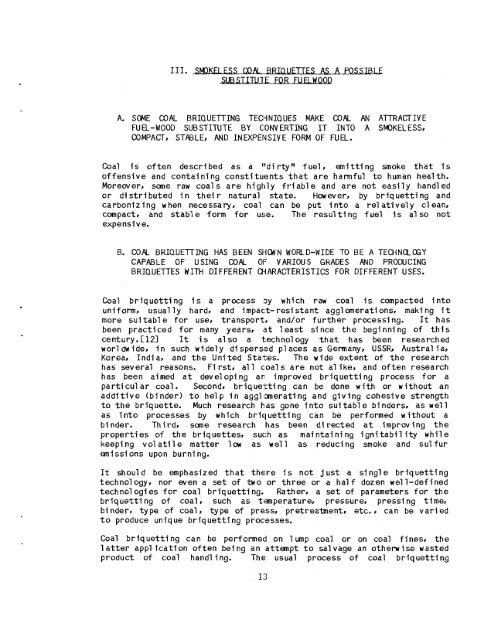Prospects for Coal Briquettes as a Substitute Fuel for Wood and ...
Prospects for Coal Briquettes as a Substitute Fuel for Wood and ...
Prospects for Coal Briquettes as a Substitute Fuel for Wood and ...
Create successful ePaper yourself
Turn your PDF publications into a flip-book with our unique Google optimized e-Paper software.
A. SONE COAL BRIQUETTING TECHNIQUES MAKE COAL AN ATTRACTIVE<br />
FUEL-MOOD SUBSTITUTE BY CONVERTING IT INTO A SMOKELESS,<br />
COMPACT, STABLE, AND INEXPENSIVE FORM OF RIEL.<br />
<strong>Coal</strong> is often described <strong>as</strong> a 'tdirtyfl fuelr emitting smoke that is<br />
offensive <strong>and</strong> contai ni ng constituents that are harmful to human health.<br />
Moreover, sune raw coals are highly friable <strong>and</strong> are not e<strong>as</strong>ily h<strong>and</strong>led<br />
or distributed in their natural state. However, by briquetting <strong>and</strong><br />
carbonizing when necessary, coal can be put into a relatively clean,<br />
compact, <strong>and</strong> stable <strong>for</strong>m <strong>for</strong> use. The resulting fuel is also not<br />
expensive.<br />
B. COAL BRIQUElTING HAS BEEN SHCWN WORLD-WIDE TO BE A TECHNCLGY<br />
CAPABLE OF USING COPL OF VARIOUS GkADES AND PRODUCING<br />
BRIQUETTES W IM DIFFERENT CHARACTERISTICS FOR DIFFERENT USES.<br />
<strong>Coal</strong> brlquetting is a process z~y which raw coal is compacted into<br />
uni <strong>for</strong>m, usual 1 y hard, <strong>and</strong> 1mpac:t- res1 stant aggl omerati ons, maki ng it<br />
more suitable <strong>for</strong> use? transport, <strong>and</strong>/or further processing. It h<strong>as</strong><br />
been practiced <strong>for</strong> many years, at le<strong>as</strong>t since the beginning of this<br />
century.Cl21 It is also a technology that ha5 been researched<br />
worldwide, in such widely dlspersed places <strong>as</strong> Germany, USSR, Austral ia,<br />
Korea, India, <strong>and</strong> the United States. The wide extent of the research<br />
h<strong>as</strong> several re<strong>as</strong>ons. First, all coals are not a1 ike, <strong>and</strong> often research<br />
h<strong>as</strong> been aimed at developing aF" improved brfquetting process <strong>for</strong> a<br />
particular coal. Second, briquetting can be done with or without an<br />
additive (binder) to help in agglmerating <strong>and</strong> giving cohesive strength<br />
to the briquette. Much research h<strong>as</strong> gone into suitable binders, <strong>as</strong> well<br />
<strong>as</strong> into processes by which briquetting can be per<strong>for</strong>med without a<br />
binder. Third, same research h<strong>as</strong> been directed at improving the<br />
properties of the briquettes, such <strong>as</strong> maintaining ignitabil ity while<br />
keeping volatile matter low <strong>as</strong> well <strong>as</strong> reducing smoke <strong>and</strong> sulfur<br />
cmissians upon burning.<br />
It should be emph<strong>as</strong>ized that there is not just a single briquetting<br />
technologyr nor wen a set of two or three or a half dozen well-defined<br />
technologies <strong>for</strong> coal briquetting. Rather, a set of parameters <strong>for</strong> the<br />
briquetti ng of coal such <strong>as</strong> tc-mperature, pressure, pressing time,<br />
binderr type of coalp type of press, pretrealnent, etc., can be varied<br />
to produce unique briquetting processes.<br />
<strong>Coal</strong> briquetti ng can be per<strong>for</strong>med on 1 ump coal or on coal fjnesr the<br />
latter appl Ication often being an attempt to salvage an otherwise w<strong>as</strong>ted<br />
product of coal h<strong>and</strong>ling. The usual process of coal briquetting<br />
1 3

















